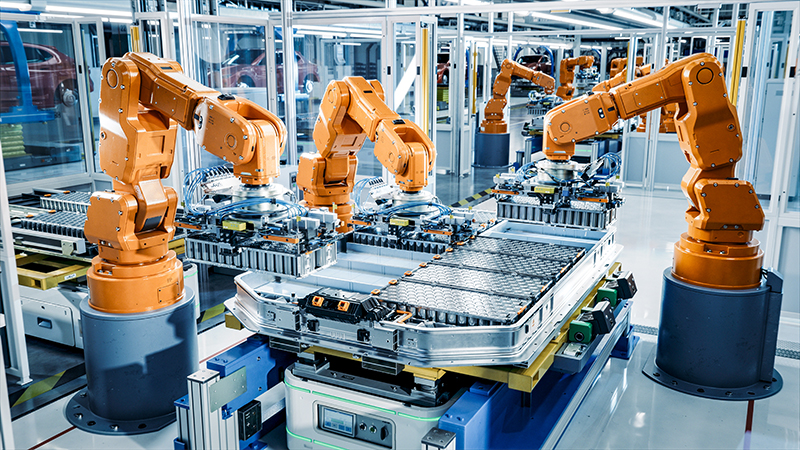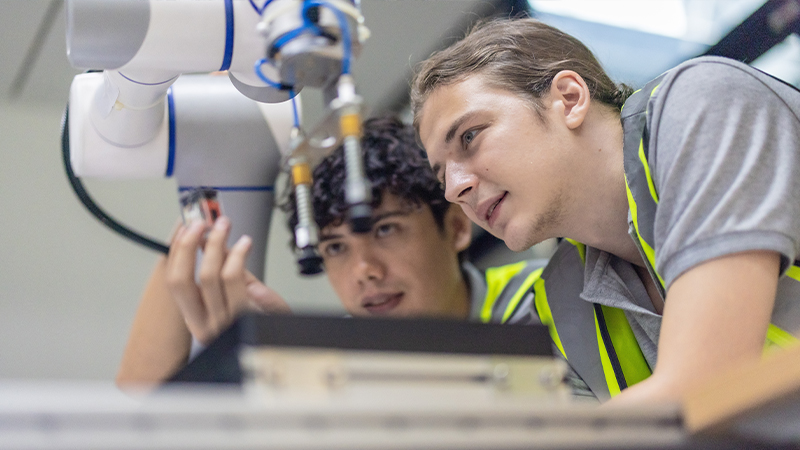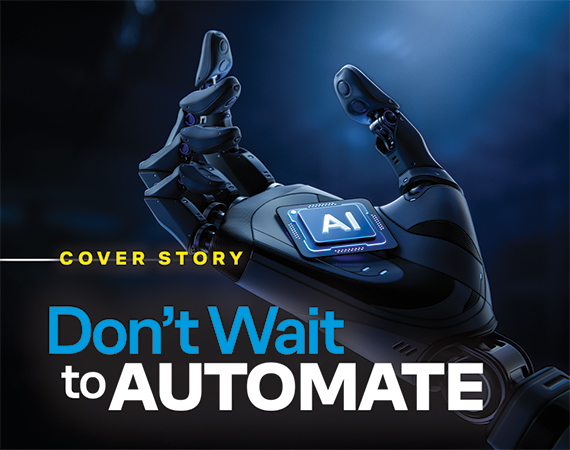When it comes to automation, manufacturers often fall into one of two camps. Some avoid it completely and default to the status quo. They’ve always done things a certain way, and it’s worked. Why change now?
Others rush to adopt technology they feel will improve nearly every aspect of operations. This top-down approach leaves many employees feeling threatened and often falls short of promised benefits.

But there’s a third route companies can take that reliably results in a significant return on investment. It also promotes employee engagement and fosters a culture of continuous improvement. Developed by Eric Blaha, one of Enterprise Minnesota’s top business growth consultants, the approach is based on three C’s: communicate, carry out, and cultivate.
By offering specific guidance within each of the C’s, Blaha helps companies build an employee-centered automation strategy that also improves overall operations. He shares two stories to highlight the importance of getting the steps right.
A manufacturer Blaha worked with recently engaged their employees in the automation conversation from the beginning. The company not only experienced improvements in the areas they were focused on for the project but also noticed employees extending the improvements and suggesting ideas for other areas of production, including moving the assembly location closer to shipping, automating testing for the product, and automating programming for the product. “They turned a core process that had required six people into a core process that required three,” Blaha says. “That allowed them to bolster the workforce in a different area that was bogged with backlog.”
Another manufacturer he knows was determined to utilize robotic welding. As leaders thought through how to integrate automation in the process, they skipped the step of seeking ideas from employees. As a result, they hadn’t fully fixtured the part they were welding, leading to inconsistency in quality and an extensive rework by the operator. “Skipping the step of early engagement with employees was a costly mistake,” Blaha says. “They paid with consistent rework and excess labor.”
The good news is that developing an automation strategy based on the three C’s doesn’t add significant cost or time to the process. Communicating with employees builds engagement and trust and guides decisions on which automation efforts to pursue. Carrying out automation builds employee morale and improves work lives by offloading the least desirable tasks while boosting quality and controlling costs. And cultivating a culture of continuous improvement and automation builds momentum for ongoing positive results.

Why now?
Manufacturers have faced a steady stream of chaos since the COVID pandemic: supply chain disruptions, severe labor shortages, runaway inflation, and now tariffs and other trade barriers threaten to drive up costs and add more uncertainty. Automation helps address these challenges.
“No one can control if tariffs hit and the parts you are buying go up in price,” Blaha says. But by effectively implementing automation into their processes, manufacturers can reduce the cost of production. “Automation will help reduce the margin shrink that could occur as supply chain disruptions and price increases due to tariffs start to take hold,” he says.
Manufacturers should also consider current and future labor supply issues when contemplating automation. While the severe labor shortages of recent years have subsided, there are currently close to seven million job openings but only five million job applicants.
“That math doesn’t work very well. The roughly two million worker gap isn’t going to be filled any time soon,” Blaha says. “Manufacturers can either continue to wrestle with the shortfall or seize the opportunity to automate to eliminate some of the persistent labor shortages that will likely continue for years.”
First things first: Communicate
Manufacturers that successfully implement automation take a systematic approach to communication. They make the company’s mission clear to employees and describe the roles employees will play in its ultimate success.
“Employees have to understand the company’s why, they have to understand how they fit into it, and they have to understand where the company is going in the future,” he says.
He emphasizes that it is important to talk about the goals of automation. Many employees may feel threatened by automation or misunderstand the reasons a manufacturer is embracing it. “There are far too many opinion articles out there telling us that automation will replace employees,” Blaha says. “Automation is meant to be a tool that can help improve an employee’s work life. It can decrease physicality with things like lift-assist devices or transport devices, which reduce the effort that employees have to put into the work they’re doing every day,” Blaha says.
“Automation is a tool employees can use to grow within the company,” he says.
Once employees understand the goals, Blaha says leaders can focus on the other key aspect of communication: discovering opportunities for automation. “A lot of the challenge is in seeing opportunity and getting our employees to see it too,” Blaha says.
Blaha illustrates the key paths to identifying automation opportunities with a Venn diagram. Blaha labels the first circle as “learning to see.” He breaks manufacturing operations into three segments: those that add value; those that don’t add value but are necessary; and those that don’t add value and amount to waste.
“Value add” includes anything a customer is willing to pay for.
“Non-value add necessary” activities are required, but don’t meet the customer’s needs, including cleaning, inspecting, paperwork, and data collection.
“Non-value add waste” includes activities a customer is unwilling to pay for and doesn’t meet their needs, or those not done right the first time.
Value add can be a good target for automation, but often some of the best opportunities come from the non-value add necessary functions. “These are the things that we do to run the business, but they add no value to the customer, like cleaning, paperwork, inspection,” he says. “They reduce tasks that people don’t enjoy doing and they do a better job at completing tasks for us.”
He describes how one company placed a super high-speed fan on the inside of a machine center to keep the windows completely free of oil. “It eliminated the need for people to clean those windows off because it was keeping them clean at all times, and it improved the operator’s ability to see what was happening inside of that machine center,” he says. “None of the operators liked cleaning the windows. They loved that implementation.”

Blaha warns that as manufacturers seek opportunities for automation, they need to be mindful of those activities that fall into the non-value add waste area, such as waiting, overproduction, and defects. Manufacturers don’t want them embedded in their processes and customers are not willing to pay for them. Blaha urges companies to identify such waste before automating. “Once we automate the waste into the process, it becomes much more difficult to get it out,” he says.
He offers the example of a 20,000-square-foot facility where it could be tempting to automate transportation between processes at opposite ends of the building using autonomous guided robots (AGRs). “You might spend $100,000 on AGRs to transport material back and forth between the two locations. But if you looked at the process, you might understand that you didn’t need to have that transportation,” he says. “Make sure you lean the process out and eliminate as much of the waste as possible before starting to think about automation.”
Blaha’s second circle of automation opportunities involves polling employees. “What tasks drive them crazy? What jobs do they hate the most? Typically those jobs are highly manual, highly physical, very difficult, and filled with opportunities for automation,” Blaha says.
The third circle embraces data analytics like ROI and time to payback. Blaha emphasizes that employers can put hard numbers on the value of automation by anticipating savings from eliminating waste and defects and increasing production.
“Many companies are thinking about two-, three-, or four-year paybacks. Those are the larger, more expensive projects,” Blaha says. “But when I think about automation, especially early in the journey, I want things to pay off sooner. There are way too many opportunities that will pay you in one year to skip over them for a five-year payback.”
Take action: Carry out
The culture of sharing goals and seeking input should continue in the carry out steps of automation. “This is where we excite, engage, and execute,” Blaha says.
He urges companies to act quickly. “If we get our employees excited and get their ideas and thoughts, but we don’t start doing things, we’ll lose that excitement,” he says.
“It’s critical that we just get started. I also believe that shorter cycles increase engagement. You want to win right away,” he says. “You want to put some numbers on the scoreboard at the start so that people know where we’re going. That gets them excited.”
Early successes build momentum, he says. “We need to start moving now because a little bit better tomorrow is better than nothing for six months.”
Blaha suggests a value stream map will help identify tasks with the greatest quick win potential. One example of automation inside a process is scanning. Inventory management historically has been manual, tracked on a spreadsheet or a tally note. A simple route to automate that task is barcoding.
He also encourages companies to consider detection. Most of the time, inspection doesn’t add value. On a rare occasion, a customer might pay for the inspection of their products, but typically inspection falls into the non-value add necessary category. “We might leak test a tank, for example. If that’s something we need, then automating that task is a great opportunity,” he says.
Blaha adds that during the carry out phase, leaders always want to keep lean thinking at the forefront. Sometimes trying to become more efficient by automating a step creates a more costly issue because it disrupts workflow. “We may have gone from a 10-second cycle time to eight-second cycle time, but we added 20 cents per part in transportation costs,” he says. “I never want to lose sight of how the product should flow.”

Another critical tenet of Blaha’s carry out phase is that trying is more important than talking. He encourages companies to conduct “try storms.” Similar to brainstorming, try storming involves coming up with ideas and simulating them on a small scale. “This is one of the best ways for us to understand when an automation effort will pay off,” he says.
Blaha offers the example of simulating what automated transportation between process steps would look like. A company could put labor in place temporarily to conduct a time study to understand it better. “When we get these ideas, we want to try them. We want to make sure that we’re not just talking about what might work in the future,” he says.
He adds three more pieces of advice for this stage of automation. First, finishing is more important than starting. Improving is more important than perfection. And, moving through this stage, leaders never want to forget about employees’ perceptions. “We always want to make sure that automation is an aid to the employee. It is not the centerpiece. If it becomes the centerpiece, people will disengage,” Blaha says.
Build momentum: Cultivate
Blaha’s third “C” in automation — celebrating success — weaves an automation mindset into the fabric of the company. “It’s critical for us to share the success, share the growth, and share the data,” he says. “That gets employees excited and motivated to seek more opportunities for automation.”
“If we increased our production by 20% and we reduced our downtime by 10% through automation solutions our employees helped us put in place, we need to celebrate that with them,” he says.
Companies should solicit reactions to the process, Blaha says. “That’s where we get some of our best improvements, because continuous improvement and automation are iterative processes. We’re not just going to implement it and be done. We want to make sure that we can keep improving and we can keep implementing those future automation steps.”
Blaha emphasizes that employees need to understand that the changes not only benefit the company but also benefit them. Companies can take concrete steps to illustrate that. “We can create some unique job titles: robot technician or robot specialist. We can give them the training they need to understand and engage them in growing themselves with our company,” Blaha says.
He also points out that as a company automates, it increases capacity. “As we gain capacity, it’s going to be critical for us to fill that capacity,” he says.
That’s when momentum begins to build, Blaha says. “As we’re automating, we’re going to develop our people. As we develop our people, we have the opportunity to invest in our facilities,” he says. “Tie those facilities improvements back so that people understand that this is possible because they are engaged in the journey. When they see how it benefits them too, it’ll be easier to keep this moving in the future.”
Return to the Fall 2025 issue of Enterprise Minnesota® magazine.


